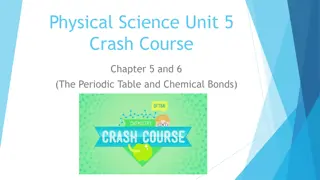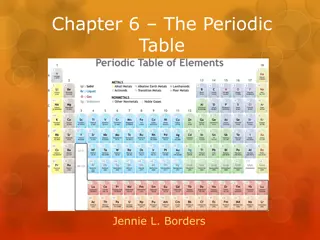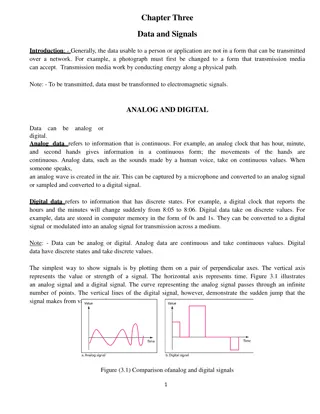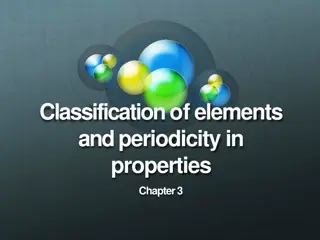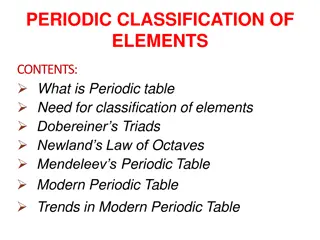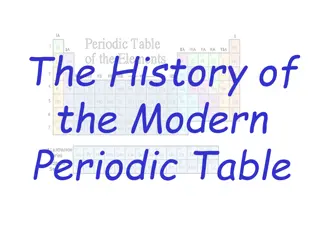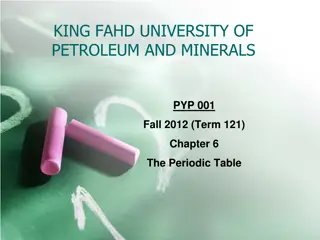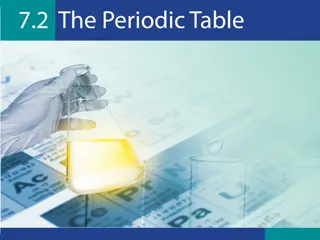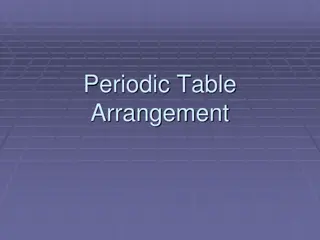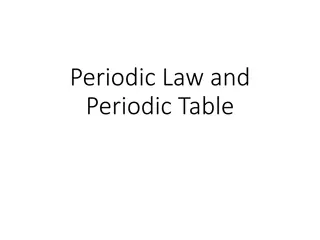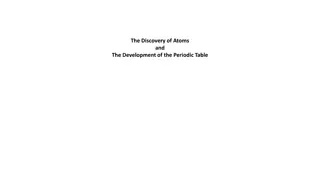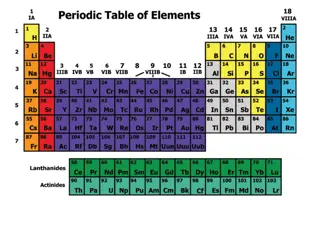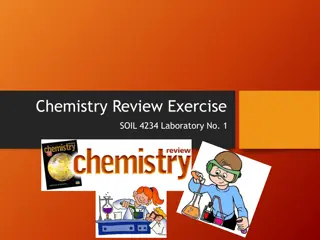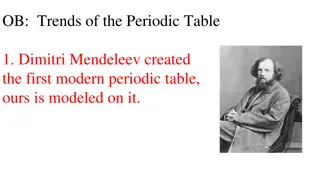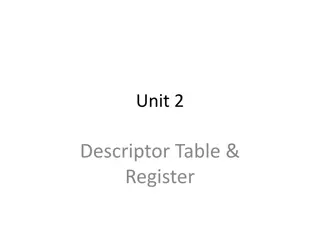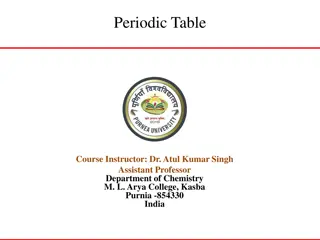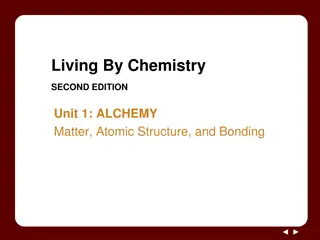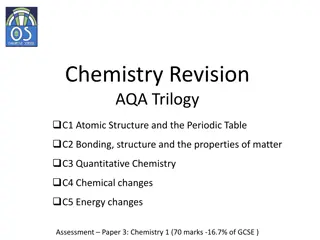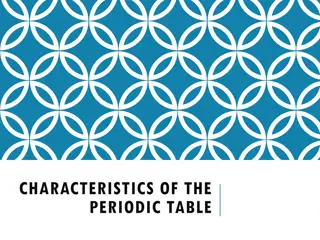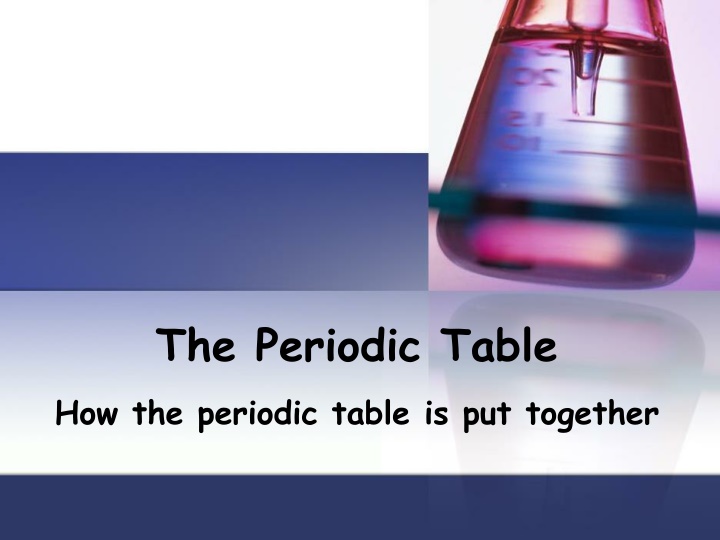
How the Periodic Table is Constructed
"Explore the history, organization, and arrangement of the periodic table guided by Dimitri Mendeleev's innovative system. Discover how periods and groups categorize elements based on electron configuration." (495 characters)
Download Presentation

Please find below an Image/Link to download the presentation.
The content on the website is provided AS IS for your information and personal use only. It may not be sold, licensed, or shared on other websites without obtaining consent from the author. If you encounter any issues during the download, it is possible that the publisher has removed the file from their server.
You are allowed to download the files provided on this website for personal or commercial use, subject to the condition that they are used lawfully. All files are the property of their respective owners.
The content on the website is provided AS IS for your information and personal use only. It may not be sold, licensed, or shared on other websites without obtaining consent from the author.
E N D
Presentation Transcript
The Periodic Table How the periodic table is put together
What is the Periodic Table? It is an organizational system for elements.
Who created it? By 1860 about 60 elements were known and a method was needed for organization. In 1869, Russian chemist Dimitri Mendeleev proposed arranging elements by atomic weights and properties. The table contained gaps but Mendeleev predicted the discovery of new elements.
So how is it arranged? The genius of the periodic table is that it is organized like a big grid. The elements are placed in specific places because of the way they look and act. If you have ever looked at a grid, you know that there are rows (left to right) and columns (up and down). The periodic table has rows and columns, too, and they each mean something different.
You've got Your Periods... Even though they skip some squares in between, all of the rows go left to right. When you look at a periodic table, each of the rows is considered to be a different period (Get it? Like PERIODic table.)
Periods = Rows In the periodic table, elements have something in common if they are in the same row. All of the elements in a period have the same number of occupied energy levels. Every element in the top row (the first period) has one energy level for its electrons. All of the elements in the second row (the second period) have two energy levels for their electrons. It goes down the periodic table like that.
And you got your groups The periodic table has a special name for its columns, too. When a column goes from top to bottom, it's called a group.
Groups = Columns The elements in a group have the same number of electrons in their outer orbital. Every element in the first column (group one) has one electron in its outer shell. Every element on the second column (group two) has two electrons in the outer shell. As you keep counting the columns, you'll know how many electrons are in the outer shell. There are some exceptions to the order when you look at the transition elements, but you get the general idea.
What do all the numbers mean ?
Other than periods and groups, the table is divided into families.
ALKALI METALS very reactive metals that do not occur freely in nature malleable, ductile, good conductors of heat and electricity. can explode if they are exposed to water
ALKLINE EARTH METALS metals very reactive (less than Alkali metals) Harder, denser than group 1 not found free in nature
TRANSITION METALS Shiny, ductile and malleable, form colored compounds and conduct electricity and heat Can put more than 8 electrons in outer shell iron, cobalt, and nickel, are the only elements known to produce a magnetic field.
RARE EARTH ELEMENTS many are man-made Bottom row are all radioactive The 4f row is called the Lanthanides b/c it comes after Lanthanum The 5f row is called the Actinides b/c it comes after Actinium
OTHER METALS are ductile and malleable are solid, have a high density,
METALLOIDS have properties of both metals and non- metals some of the metalloids are semi- conductors. This means that they can carry an electrical charge under special conditions. This property makes metalloids useful in computers and calculators
NON-METALS not able to conduct electricity or heat very well very brittle Do not reflect light.
HALOGENS "halogen" means "salt-former" and compounds containing halogens are called "salts" exist in all three states of matter. At room temperature, Fluorine and Chlorine are gases, Bromine is a liquid (1 of only 2 elements that is a liquid at room temp) and Iodine and Astatine are solids.
NOBLE GASES do not form compounds easily Happy/Inert Elements (Full outer shells) All have 8 valence electrons except Helium which has a full energy level containing only 2 electrons


